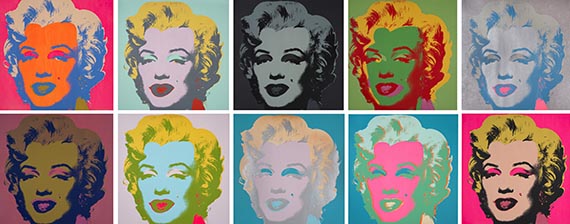Dictionary


Lithography
Lithography [Greek: "líthos" = stone; "graphein" = to write] is a planographic printing technique. Printing is not done via a drawing that is sunk or raised on a block; instead the printing parts are flush with the non-printing ones. Invented by Aloys Senefelder of Munich in 1796-1798, the lithographic printing process exploits the reciprocally repellent properties of oil and water. For printing a drawing executed in greasy lithographic crayon or lithographic ink on fine-textured, specially prepared (polished, grained each time used and all oily substances removed) slabs of limestone. Then the slab is covered with a resist (gum arabic, etc) and a biting liquid (nitric acid), which causes the reserved areas of the slab to be slightly etched and particularly hydrophilic (water-absorbent and grease-resistant). After the stone has dried, the lines of the drawing are washed out with an oily solvent (turpentine, paraffin. What remains on the stone is the drawing as a greasy ground to which the printing ink is applied. The greasy parts of the slab - the drawing - attract the greasy lithographic ink and are water-repellent. The rest of the slab binds water to the remains of the gum arabic layer and accepts no ink. Lithography enables an artist to apply a drawing with pen or brush, with greasy crayons or pencils. That means, he can vary the character of the lines in his print. Hence lithography very closely approximates the expressive qualities of the original drawing. In lithography the limestone from around Solnhofen (Bavaria: the Franconian Jura) is preferred in Germany and elsewhere. Lithography is an economical technique which allows for a very large volume of prints. Further, it is easy to handle and a knowledge of chemistry is not required. Moreover, the stone plate can be cleaned and de-acidified for repeated re-use. It was not long before lithography was discovered as an ideal medium for making advertising posters. It was the forerunner of modern offset printing, which is also a planographic printing process. The drawing is usually done in mirror-image on the stone and then printed on paper. To avoid this, the drawing can be executed in advance in the same medium on paper and then transferred to the stone (transfer lithography). Although it is definitely disputable whether such prints can be called originals, many distinguished artists have used transfer lithography, including Daumier and Toulouse-Lautrec as well as Nolde, Barlach, Kollwitz, Matisse and Kokoschka. Transfer lithography does result in a loss of quality in the printed picture. Lithography makes colored printing equally possible. Toulouse-Lautrec especially preferred prints in large formats with coloring that was easy to handle with just a few inked slabs.
Lithography [Greek: "líthos" = stone; "graphein" = to write] is a planographic printing technique. Printing is not done via a drawing that is sunk or raised on a block; instead the printing parts are flush with the non-printing ones. Invented by Aloys Senefelder of Munich in 1796-1798, the lithographic printing process exploits the reciprocally repellent properties of oil and water. For printing a drawing executed in greasy lithographic crayon or lithographic ink on fine-textured, specially prepared (polished, grained each time used and all oily substances removed) slabs of limestone. Then the slab is covered with a resist (gum arabic, etc) and a biting liquid (nitric acid), which causes the reserved areas of the slab to be slightly etched and particularly hydrophilic (water-absorbent and grease-resistant). After the stone has dried, the lines of the drawing are washed out with an oily solvent (turpentine, paraffin. What remains on the stone is the drawing as a greasy ground to which the printing ink is applied. The greasy parts of the slab - the drawing - attract the greasy lithographic ink and are water-repellent. The rest of the slab binds water to the remains of the gum arabic layer and accepts no ink. Lithography enables an artist to apply a drawing with pen or brush, with greasy crayons or pencils. That means, he can vary the character of the lines in his print. Hence lithography very closely approximates the expressive qualities of the original drawing. In lithography the limestone from around Solnhofen (Bavaria: the Franconian Jura) is preferred in Germany and elsewhere. Lithography is an economical technique which allows for a very large volume of prints. Further, it is easy to handle and a knowledge of chemistry is not required. Moreover, the stone plate can be cleaned and de-acidified for repeated re-use. It was not long before lithography was discovered as an ideal medium for making advertising posters. It was the forerunner of modern offset printing, which is also a planographic printing process. The drawing is usually done in mirror-image on the stone and then printed on paper. To avoid this, the drawing can be executed in advance in the same medium on paper and then transferred to the stone (transfer lithography). Although it is definitely disputable whether such prints can be called originals, many distinguished artists have used transfer lithography, including Daumier and Toulouse-Lautrec as well as Nolde, Barlach, Kollwitz, Matisse and Kokoschka. Transfer lithography does result in a loss of quality in the printed picture. Lithography makes colored printing equally possible. Toulouse-Lautrec especially preferred prints in large formats with coloring that was easy to handle with just a few inked slabs.
Offers
Headquarters
Joseph-Wild-Str. 18
81829 Munich
Phone: +49 89 55 244-0
Fax: +49 89 55 244-177
info@kettererkunst.de
Louisa von Saucken / Undine Schleifer
Holstenwall 5
20355 Hamburg
Phone: +49 40 37 49 61-0
Fax: +49 40 37 49 61-66
infohamburg@kettererkunst.de
Dr. Simone Wiechers / Nane Schlage
Fasanenstr. 70
10719 Berlin
Phone: +49 30 88 67 53-63
Fax: +49 30 88 67 56-43
infoberlin@kettererkunst.de
Cordula Lichtenberg
Gertrudenstraße 24-28
50667 Cologne
Phone: +49 221 510 908-15
infokoeln@kettererkunst.de
Hessen
Rhineland-Palatinate
Miriam Heß
Phone: +49 62 21 58 80-038
Fax: +49 62 21 58 80-595
infoheidelberg@kettererkunst.de
We will inform you in time.




